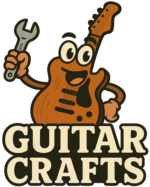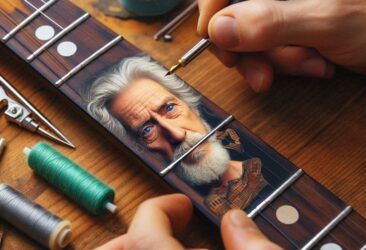When it comes to building your own instrument, customizing fretboards: inlays, radius, and leveling in guitar kits can dramatically elevate your playing experience and your guitar’s visual appeal. These seemingly small details can have a huge impact on both playability and tone. Whether you’re after a sleek modern neck feel or vintage-inspired fingerboard art, understanding how to personalize this critical part of your guitar will help you create an instrument that’s uniquely yours.
1. Introduction to Fretboard Customization
Understanding the Basics of Guitar Fretboards
The fretboard, or fingerboard, is the part of the guitar neck where you press down the strings. It directly affects your interaction with the instrument, influencing feel, tone, and comfort.
The Importance of Personalizing Your Instrument
Customization is more than just aesthetics—it’s about optimizing the guitar for your specific hands, playing style, and tonal goals. Small tweaks like adjusting the radius or refining fretwork can make the difference between an average and an exceptional playing experience.
Overview of Commonly Customized Features
The most common fretboard modifications in electric guitar kits include:
- Custom fret inlays for style and visibility
- Adjusting the fretboard radius for tailored playability
- Fret leveling and dressing for improved intonation and smoother action
- Fingerboard replacement or reshaping in advanced builds
** Here’s a little transparency: Our website contains affiliate links. This means if you click and make a purchase, we may receive a small commission. Don’t worry, there’s no extra cost to you. It’s a simple way you can support our mission to bring you quality content. **
As an Amazon Associate, I earn from qualifying purchases.
2. Custom Fret Inlays: A Personal Touch
What Are Fret Inlays and Their Purpose?
Fret inlays are decorative or functional markers embedded into the fretboard. Typically found at standard fret positions (3rd, 5th, 7th, etc.), they help players visually navigate the neck.
Can You Get Custom Fret Inlays? Absolutely, Here’s How
Yes — you can design or order custom inlays to reflect your personal style. From initials to intricate patterns or symbols, builders can use pre-cut inlays, laser-etched inserts, or even hand-cut shell and pearl designs.
If you’re feeling adventurous, check out our guide on How To Create Custom Inlays For Your Guitar Fretboard.
Popular Inlay Designs and Materials
Common materials include mother-of-pearl, abalone, acrylic, and exotic woods. Popular designs range from dots and blocks to vines, skulls, tribal art, and even LED lights.
The Process of Installing Custom Inlays
- Mark your layout accurately on the fretboard.
- Rout the cavities with precision tools or a Dremel.
- Glue and clamp the inlays securely.
- Sand flush to ensure a smooth playing surface.
- Fill any gaps with epoxy or fine sawdust/glue mix.
3. Understanding Fretboard Radius and Its Role
What is Fretboard Radius?
The radius is the curvature of the fretboard across its width. Measured in inches, a smaller radius (e.g., 7.25″) has more curve, while a larger radius (e.g., 12″, 16″) is flatter.
How Fretboard Radius Affects Playability
- Rounder radius: Easier for chord playing and vintage feel
- Flatter radius: Better for low action and bending without fretting out—ideal for lead players
Many modern guitars use compound radius boards, which combine the benefits of both curved and flat designs.
Methods to Adjust the Fretboard Radius
To modify the radius:
- Re-sand the fretboard using a radius block to the desired curvature
- Ensure consistency by checking frequently with radius gauges
Using a Radius Block for Precision
A radius sanding block is essential for achieving an even and accurate curve across the entire fretboard. Always use long, smooth strokes and check your progress often. This block will also come into play during fret leveling (see below).
4. The Art and Science of Leveling Frets
Why Leveling Frets is Essential for Quality Sound
Uneven frets lead to buzzing, intonation issues, and poor sustain. Leveling ensures that each fret is the proper height for clean, consistent play.
Can You Use a Radius Block to Level Frets? Yes, Here’s How
Absolutely. Once frets are installed, you can wrap sandpaper around your radius block and use it to sand all frets simultaneously to a consistent level. This preserves the correct curvature and ensures even string response.
Tools and Techniques for Accurate Fret Leveling
- Radius block or fret leveling file
- Marker pen to mark fret tops before sanding
- Crowning file to reshape frets after leveling
- Fret rocker to detect uneven frets
Once leveled, frets must be crowned, polished, and cleaned for smooth playability.
For detailed fret work, visit Refretting Your Electric Guitar Kit: When And How To Do It.
Avoiding Common Mistakes During Fret Leveling
- Not checking radius consistency before starting
- Skipping the crowning and polishing steps
- Using overly aggressive tools that damage frets or wood
- Leveling without first securing the neck properly
5. Changing and Leveling Your Guitar Fingerboard
Can You Change Fretboard Inlays? Steps to Follow
Yes, but it requires careful routing and removal. Here’s a simplified process:
- Heat and gently remove old inlays
- Clean cavities thoroughly
- Rout or expand as needed for new inlays
- Install and finish as outlined above
Refer to Customizing Your Electric Guitar Kit With Unique Fretboard Inlays for additional tips and inspiration.
How to Level a Guitar Fingerboard Effectively
If your build requires fingerboard leveling before fret installation, use a leveling beam or long sanding block:
- Secure the neck flat
- Sand evenly with a grit appropriate for the wood type
- Check your work with a straightedge frequently
Factors to Consider During Fingerboard Adjustment
- Wood type: Softer woods like rosewood can sand quickly — be gentle
- Neck relief: Ensure neck is perfectly straight before sanding
- Fret slot depth: Don’t over-sand and compromise the slots
Ensuring a Smooth Transition and Sound Enhancement
The goal is to create a flat or properly radiused playing surface that complements the rest of your build. This not only helps playability but also ensures your action can be set low without buzzing — especially once you start Setting Up The Bridge And Neck On Your Electric Guitar Kit.
Final Thoughts…
Customizing the fretboard is one of the most rewarding parts of building a guitar kit. From inlays that reflect your identity, to a tailored radius that enhances your technique, and meticulously leveled frets that play clean from the first note — you’re crafting more than an instrument. You’re creating a tool that fits your hands and vision.
For deeper customization and to perfect your tone, don’t miss:
- How Pickup Position Affects Electric Guitar Tone In Kits
- How To Choose Between Neck-Through And Bolt-On Necks In Kits
- Essential Tools Every Electric Guitar Kit Builder Should Have
There are 100’s of ways you can build a business around your passion for guitar building.



This is a wonderfully insightful guide—customizing fretboards truly elevates both the look and feel of a guitar kit in meaningful ways. I especially appreciate how you emphasize that the fretboard isn’t just aesthetic—it directly shapes playability through inlays, radius, and fret refinement. The breakdown of each customization step is especially useful: choosing or crafting custom inlays to infuse personal style; adjusting the fretboard radius to align with one’s playing preferences and goals; and leveling, crowning, and polishing frets to ensure clean tone and smooth action. It’s clear how even small tweaks can dramatically enhance the experience of playing the instrument.
One thought that stood out to me is how satisfying these customizations are—not only do they refine tone and comfort, but they also deepen your connection with the instrument. Kudos for balancing technical guidance with the creative spirit of guitar building—this could inspire both first-time builders and seasoned tinkerers.
Thank you so much! I’m really glad the guide resonated with you. You’re absolutely right! Customizing the fretboard isn’t just about looks; it has a huge impact on playability and feel, and those small tweaks can make a big difference in tone and comfort.
It’s especially rewarding to see builders connect with their instruments through these personal touches. Whether it’s crafting inlays, refining the radius, or perfecting the frets, each step adds a sense of ownership and creativity that really elevates the experience.
I appreciate your thoughtful feedback, and I hope it inspires more builders, both new and experienced, to experiment and make their guitars truly their own!
Thanks again,
~Wayne
Customizing fretboards is one of those details that separates a standard kit build from a truly personal instrument. I really like how this post highlights not just the visual upgrades, like custom inlays, but also the functional improvements such as radius adjustment and fret leveling. These refinements have a massive impact on playability—whether you prefer a rounder radius for smooth chord work or a flatter one for effortless bends and leads. The step-by-step breakdown makes the process feel approachable, even for builders tackling their first kit. I especially appreciate the reminder that precision and patience are key—tools like radius blocks and crowning files may seem small, but they ensure professional results. In the end, customizing your fretboard isn’t just about looks; it’s about building a guitar that feels and sounds exactly right for you. Excellent guide for any DIY luthier!
Thank you so much for the thoughtful comment! I’m glad the guide highlighted both the visual and functional aspects of fretboard customization! Those small refinements really do make a huge difference in playability. You’re absolutely right: radius adjustment, fret leveling, and careful use of tools like crowning files are what turn a kit into a guitar that feels and plays like it was made just for you. I’m thrilled to hear the step-by-step breakdown felt approachable, even for first-time builders.
I really appreciate you taking the time to share your thoughts!
~Wayne